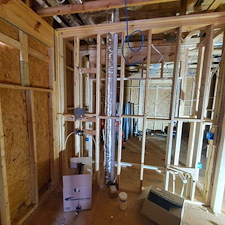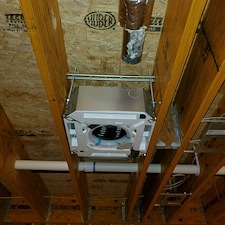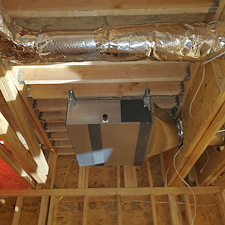New Construction Installation with High Efficiency Mitsubishi Systems Atlanta, GA

We provide full-service assistance from start to finish. Our team will work with you to plan the most efficient HVAC system tailored to your home and specific needs. We specialize in designing the optimal duct system for maximum efficiency, selecting the best equipment, and installing everything from ductwork to water heaters and dehumidifiers. Count on us for a seamless and comprehensive solution for all your HVAC needs.
1. Design and Planning
- Load Calculation: Perform a Manual J calculation to determine the heating and cooling load requirements for the building. This considers the size of the building, insulation, windows, orientation, number of occupants, and more.
- System Type Selection: Choose an appropriate HVAC system (e.g., split system, ductless mini-splits, geothermal, or packaged units). Factors like energy efficiency, climate, and building layout influence the choice.
- Ductwork and Vents Design: Design the ductwork layout and ventilation system to ensure proper airflow throughout the building. Proper sizing and placement of ducts and vents are essential for efficiency and comfort.
2. Selecting Equipment
- Furnace, AC, or Heat Pump: Choose the right equipment based on the calculated load requirements and system type. For example, select a high-efficiency furnace or air handler for heating and an appropriate air conditioning unit or heat pump for cooling.
- Air Filtration & Air Quality Systems: Choose air filters, air purifiers, humidifiers, or dehumidifiers depending on air quality needs and local climate conditions.
- Smart Thermostats: Install programmable or smart thermostats for efficient energy management and temperature control.
3. Ductwork Installation
- Duct Fabrication & Installation: Fabricate and install ducts that are sized properly according to the design. Ducts should be insulated to reduce energy loss and prevent condensation.
- Sealing & Testing: Seal all duct connections and perform a duct leakage test to ensure efficiency. Ductwork must be properly sealed to prevent air loss.
4. System Installation
- Mounting HVAC Units: Install the furnace, air conditioner, or heat pump units in their designated spaces. This may involve setting up outdoor units (for split systems) or placing them in utility rooms, attics, or basements.
- Connecting to Ducts: Connect the HVAC units to the ductwork and ensure that all connections are airtight.
- Power and Gas Supply: For gas furnaces, ensure that the gas lines are properly connected. For all systems, ensure the proper electrical wiring is installed to power the units and thermostats.
5. Ventilation and Airflow
- Air Balance: Test and adjust the airflow through the duct system to ensure even distribution of conditioned air throughout the building.
- Fresh Air Intake: Set up ventilation systems to bring in fresh air, especially if the building is tightly sealed, to improve indoor air quality.
- Exhaust Systems: Install exhaust fans in kitchens, bathrooms, and laundry rooms to manage moisture and odors.
6. System Testing & Commissioning
- Testing for Proper Operation: Once the system is installed, test it to make sure everything is working as expected. This includes checking the thermostat functionality, system cycling, heating/cooling effectiveness, and airflow.
- Refrigerant Levels: If installing an air conditioner or heat pump, check refrigerant levels and ensure that they are within the manufacturer's recommended specifications.
- Energy Efficiency Checks: Verify that the system is performing efficiently by measuring the system’s power usage and airflow.
7. Final Inspections
- Code Compliance: Ensure that the installation complies with local building codes, including electrical, gas, and ventilation codes.
- Inspection: Local authorities or a third-party inspector may need to inspect the system to confirm proper installation.
8. Customer Handover & Education
- Owner Training: Educate the homeowner or building manager on how to operate the HVAC system, including how to use thermostats, perform routine maintenance, and recognize signs of potential issues.
- Maintenance Instructions: Provide guidelines on regular maintenance tasks like changing filters, checking for blockages, and cleaning coils to ensure long-term system efficiency and longevity.
9. Ongoing Maintenance
- Set up a maintenance schedule for the system, including seasonal inspections, filter changes, and tune-ups to maximize efficiency and extend the system’s lifespan.
Whether you're building your dream home or renovating your current space, let us bring comfort, efficiency, and peace of mind to your home with our expert HVAC solutions.
Contact Southern Home Performance Today to Get Started!
Service provided: Zoning Systems
Location: Atlanta, GA
Project Image Gallery
Products Used
-
Mitsubishi




